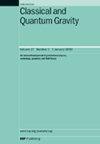Newtonian noise introduced by impellers in LIGO Voyager and Cosmic Explorer gravitational wave observatories
IF 3.6
3区 物理与天体物理
Q2 ASTRONOMY & ASTROPHYSICS
引用次数: 0
Abstract
Third generation ground-based gravitational wave detectors are proposing the use of cryogenics. The low-temperature regime will require a cooling-down system capable of removing heat from test masses and maintaining its low temperature. The present study analyzes the Newtonian noise introduced by rotating impellers used in a cooling-down system with sub-cooled nitrogen circulating in a loop. In order to calculate this noise, a computational model was developed and the results were compared to the LIGO Voyager and Cosmic Explorer design sensitivity curves. For a system using two impellers having three blades each, the model shows that this Newtonian noise is always below the sensitivity curve if their distance to the test mass center is greater than 2.3 m for LIGO Voyager and 2.4 m for Cosmic Explorer. In addition, our calculations showed zero noise values for specific impeller’s locations, depending on the blade number. This revealed a new region where it is possible to minimize the noise.由LIGO旅行者号和宇宙探索者号引力波天文台的叶轮引入的牛顿噪声
第三代地面引力波探测器建议使用低温技术。低温状态将需要一个冷却系统,能够从测试质量中除去热量并保持其低温。本文分析了过冷氮气循环冷却系统中旋转叶轮所引入的牛顿噪声。为了计算这种噪声,建立了一个计算模型,并将结果与LIGO旅行者号和宇宙探索者号设计的灵敏度曲线进行了比较。对于使用两个叶轮,每个叶轮有三个叶片的系统,该模型表明,如果它们与测试质量中心的距离大于2.3 m (LIGO Voyager)和2.4 m (Cosmic Explorer),则牛顿噪声始终低于灵敏度曲线。此外,我们的计算表明,根据叶片数量的不同,特定叶轮位置的噪声值为零。这揭示了一个新的区域,在那里可以将噪音降到最低。
本文章由计算机程序翻译,如有差异,请以英文原文为准。
求助全文
约1分钟内获得全文
求助全文
来源期刊

Classical and Quantum Gravity
物理-天文与天体物理
CiteScore
7.00
自引率
8.60%
发文量
301
审稿时长
2-4 weeks
期刊介绍:
Classical and Quantum Gravity is an established journal for physicists, mathematicians and cosmologists in the fields of gravitation and the theory of spacetime. The journal is now the acknowledged world leader in classical relativity and all areas of quantum gravity.
 求助内容:
求助内容: 应助结果提醒方式:
应助结果提醒方式:


